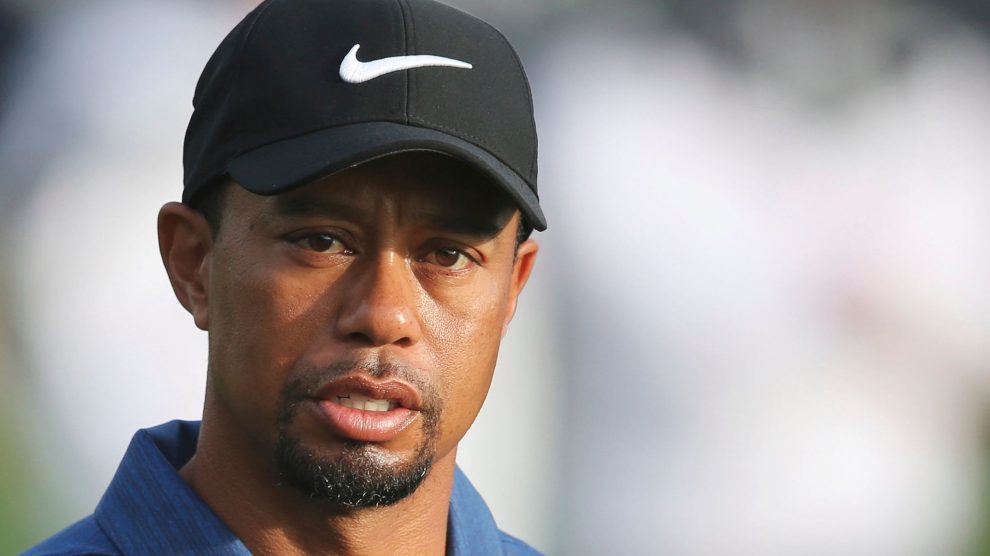The promise of Tiger Woods was always hyperbole.
That is not to say he disappointed on the golf course, where he exceeded any reasonable expectation for such a phenomenal young talent on his way to becoming one of — if not the — greatest player of all time. But the hype morphed into an indictment on him as a person, where no level of grace could have matched the pompous predictions that he helped create and foster.
This dichotomy of professional greatness undercut by personal failings will always be the lasting legacy of Woods. He has an indelible record of athletic heroics, one that spans from his teenage years to his 45th birthday, just passed on Dec. 30. But just as notable is how the weight of excessive fame buried him, and pinned him in an underworld of lurid sexual escapades and drug abuse, only recently rising to see light again.
Woods is a quintessential American story, and it is one that has been told ad nauseam over the past four decades. Each new detail that emerges from the rare moments he spent away from the camera fills in only the smallest pieces of the puzzle. There are only small pieces left.
So it is not surprising that the newest walk down this well-worn narrative path does not feel fresh, even if the HBO documentary, “Tiger,” is slick and sensational. It stays rigidly true to its source material, the 2018 book, “Tiger Woods,” authored by Jeff Benedict and Armen Keteyian, both of whom are executive producers for the film. The book was masterfully reported, but read like liner notes to a remastered edition of Sergeant Pepper’s.
The first of two 90-minute parts airs on Sunday, with interviews and insights from a lot of the same people that have opined before. Woods did not participate, and the angst inside the head of his longtime handler, Mark Steinberg, can be heard by anyone who has dealt with a sleight-of-hand raconteur. No surprise, then, that most of the participants have been shunned or downright disowned by Woods and his camp, including former caddie Steve Williams, high-school girlfriend Dina Parr, and his father’s friend and biographer, Pete McDaniel.
If there is bloody news to be drained from this stone, then it comes in the form of a cliffhanger at the end of Part I, when tabloid sweetheart and Woods’ infamous former paramour, Rachael Uchitel, begins to sit for a revealing interview.
“For the last 10 years, I have stayed quiet about this story,” she says -- incorrectly -- well into Part II, which is set to air Jan. 17. “At this point, I have nothing left to lose. My name hasn’t lost the stigma at all. It’s always been, ‘Rachael Uchitel, comma, Tiger Woods’ mistress.’”
Uchitel shares some interesting details about what happened leading up to Woods’ car crash on Thanksgiving night, 2009, which led to his private life being on the front page of the New York Post more consecutive days than the terrorist attacks of Sept. 11. But rehashing it all feels almost unnecessarily hurtful, tinged with the pungent smell of an interview with a former editor from the National Enquirer just to make the viewer’s skin crawl.
If the film drives home one point, it is the humanity of an icon. It’s good to be reminded of the arrogance of Woods’ father, Earl, whose comparisons of Tiger to Gandhi and Nelson Mandela act as a dramatic voiceover to familiar home movies. There is no shortage of examining the relationship of father and son, and no punches are pulled concerning Earl’s extramarital habits. An emotional high point comes with an interview from Joe Grohman, a pro from The Navy Golf Course in Cypress, Calif., where Woods learned the game.
“He’s not going to like this,” Grohman said as he turns away from the camera before telling a damning story from that era. “Sorry, champ,” he adds, with tears in his eyes.
Heartstrings like those are low-hanging fruit, which doesn’t make their tug any less impactful. The former girlfriend, Dina Parr, even dusted off some old home videos she had of Woods letting loose as a teenager, dancing and acting goofy and feeling awkward as she pinned a boutonniere to his lapel before prom. There is an inherent sadness to those videos now, knowing that wide-eyed innocence was going to die fiery death. Worse is knowing that Woods himself was going to light the funeral pyre.
But if there is empathy to be had, it should be directed towards Woods’ spurned wife, Elin, and their two young children. Often overlooked in the maw of his demise is the existence of life in his wake. Elin read in real time about her husband’s affairs with waitresses and porn stars and escorts, and some day, if it hasn’t already come, his children are going to find those tabloid covers and they aren’t going to laugh at the puns.
Yet as much as there is a bloodlust to see a fall from grace, redemption is even more coveted. Woods has reemerged in the past two years as a hero to so many, dropping a lot of his stoic demeanor, befriending young pro golfers who grew up idolizing him, and rebuilding his own game after spinal fusion surgery that had him telling people he might never play again. The film is forced to stray from the book to shoehorn in Woods’ victory at the 2019 Masters, his 15th career major championship and likely the second-most celebrated behind his first, as a fresh-faced kid at Augusta National 22 years prior.
All that happened in between created one of the most fascinating stories in the annals of American iconography. Retelling it might be redundant, but no less valuable.

